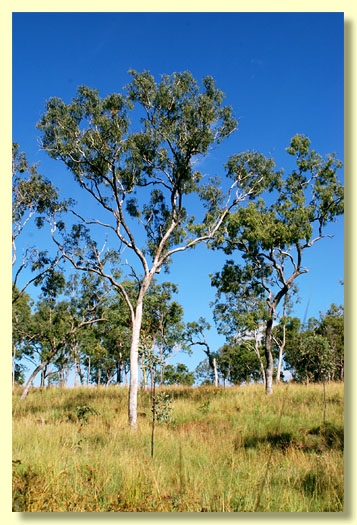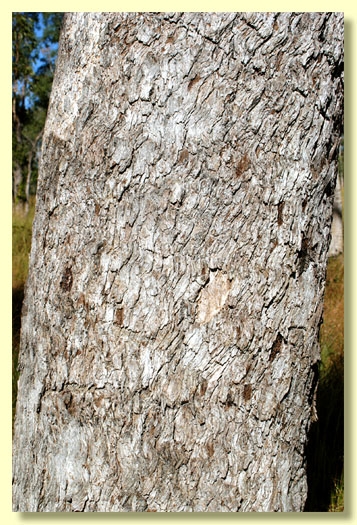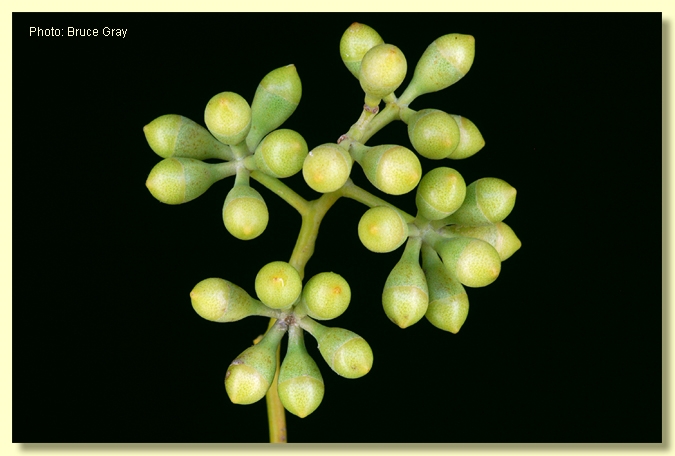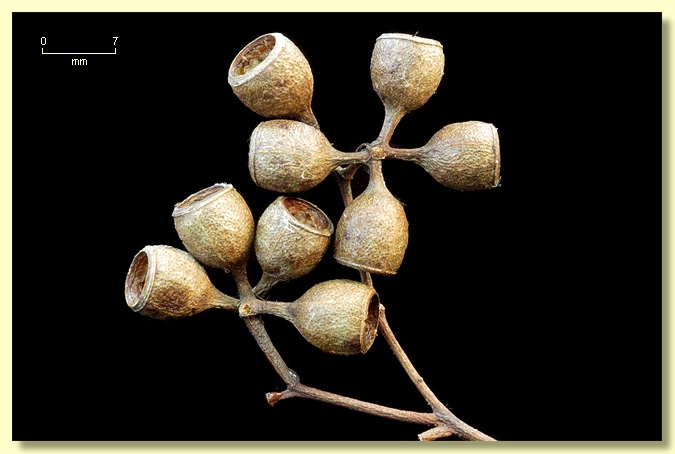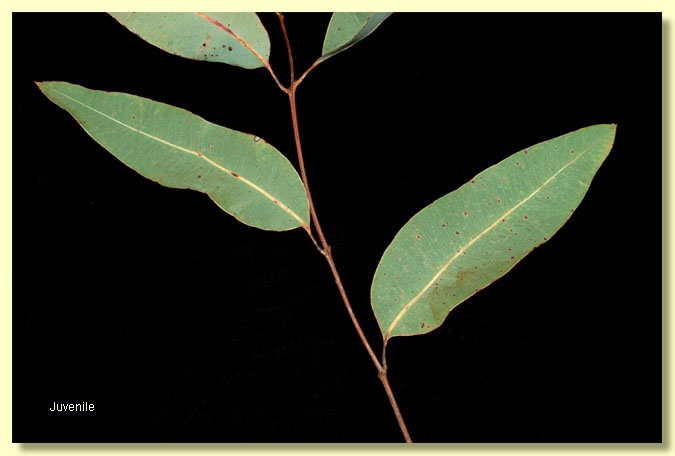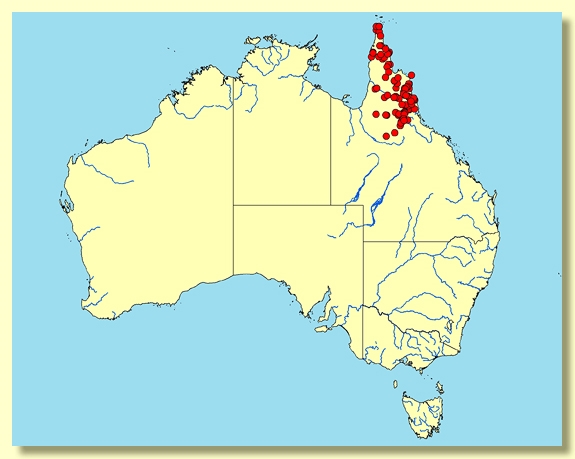Euclid - Online edition
Eucalyptus leptophleba
Eucalyptus | Symphyomyrtus | Adnataria | Apicales | Aquilonares | Fortes
Eucalyptus leptophleba F.Muell., J. Proc. Linn. Soc., Bot. 3: 86 (1859).
Eucalyptus drepanophylla var. leptophleba (F.Muell.) Luehm. ex Burtt-Davey in L.H.Bailey, Cycl. Amer. Hort. 553 (1900). T: Queensland: Gilbert River, 1857, F.Mueller; holo: MEL; iso: K.
Eucalyptus stoneana F.M.Bailey, Queensland Agric. J. 23: 259 (1909). T: Queensland: Stannary Hills, Sept. 1909, T.L.Bancroft s.n.; holo: BRI; iso: K, NSW.
Tree to 20 m tall, sometimes slightly taller. Forming a lignotuber.
Bark rough to small branches, finely fissured, box-type, grey.
Branchlets lack oil glands in the pith; normally not glaucous, rarely glaucous; branches sometimes weeping.
Juvenile growth (coppice or field seedlings to 50 cm): stems rounded to square in cross-section; juvenile leaves always petiolate, alternate, ovate to broadly lanceolate, 4.5–13 cm long, 2.5–5.8 cm wide, base tapering to rounded, grey-green.
Adult leaves alternate, petioles 1.3–3.3 cm long; blade lanceolate to narrowly so, or falcate, 10–25 cm long, 1.2–3(4) cm wide, base tapering to petiole, margin entire, apex pointed, concolorous, sometimes slightly discolorous, dull, green to blue-green to rarely glaucous, side-veins acute or at more than 45° to midrib, reticulation very dense, intramarginal vein close to margin, oil glands absent or sparse, intersectional.
Inflorescence terminal compound, peduncles ± rounded, 0.5–1.5 cm long; umbels 7-flowered, rarely 3-flowered, pedicels 0.2–0.8 cm long. Mature buds obovoid, 0.7–1.1 cm long, 0.4–0.6 cm wide, normally not glaucous, rarely glaucous, scar present (outer operculum shed early), operculum conical to rounded, stamens usually irregularly flexed, all fertile, anthers adnate, basifixed, globoid, dehiscing by lateral slits, style long and straight, stigma blunt, locules 4, the placentae each with 4 vertical ovule rows. Flowers white.
Fruit pedicellate (pedicels 0.2–0.8 cm long), cupular to barrel-shaped, normally not glaucous, rarely glaucous, 0.6–1 cm long, (0.5)0.7–1.1 cm wide, disc descending, valves 4, rim level or slightly exserted.
Seeds dark brown, 2–3(3.5) mm long, flattened-ovoid, dorsal surface shallowly reticulate, hilum ventral.
Cultivated seedlings (measured at ca node 10): cotyledons large, reniform; stems rounded to square in cross-section; leaves always petiolate (petioles 0.4–1.2 cm), opposite for 6 to 9 nodes then becoming alternate, lanceolate to broadly so, 5–13.5 cm long, 1.5–3.8 cm long, base tapering, apex pointed, dull, green, ± concolorous.
Flowering has been recorded in January, February, March, April and June.
A medium-sized tree endemic to far north Queensland from the Hughenden–Richmond–Croydon area, north through the drier western part of the Atherton Tablelands, then up the eastern side of Cape York Peninsula to Thursday Island in the Torres Strait, with a few occurences on the western side of Cape York Peninsula in the Weipa area, the Koolatah area, and the area north-west of Mungana. It has also been collected in southern Papua New Ginea, in the Morehead area. It occurs in lowland river valleys and on gentle slopes to quite high altitudes (locally), on alluvial sandy to loamy soils.
Eucalyptus leptophleba is characterised by the rough box bark to the small branches, the ovate to broadly lanceolate grey-green juvenile leaves, the dull adult leaves, often long and pendulous in the crown and the relatively large cup-shaped to barrel-shaped fruit to 1.1 cm wide.
In the classification of Brooker (2000) Eucalyptus leptophleba belongs in Eucalyptus subgenus Symphyomyrtus section Adnataria (the boxes) because the buds have two opercula, ovules are in four rows, seeds are flattened-ovoid, cotyledons are reniform, and anthers are rigid on the staminal filaments. Within section Adnataria, E. leptophleba belongs to a subgroup of box species with tropical distribution, series Aquilonares subseries Fortes, having inflorescences terminal on the branchlets, adult leaves very densely reticulate and fruit that are not fragile and have valves more or less at rim level when dehisced.
Eucalyptus leptophleba is closely related to E. patellaris from the Top End of the Northern Territory. Both are weakly separated by the shape of their fruit with E. patellaris having campanulate to cup-shaped fruit with the rim often prominently flared.
Within its area of occurrence E. leptophleba could be confused with E. chlorophylla and E. persistens, both box species with rough bark to the small branches. E. chlorophylla differs by having glossy adult leaves and smaller fruit to 0.7 cm wide. E. persistens differs by having much smaller fruit to 0.4 cm wide.
Eucalyptus leptophleba: Greek leptos - fine, small, thin and phlebos - vein, referring to the fine veins of the leaves.

